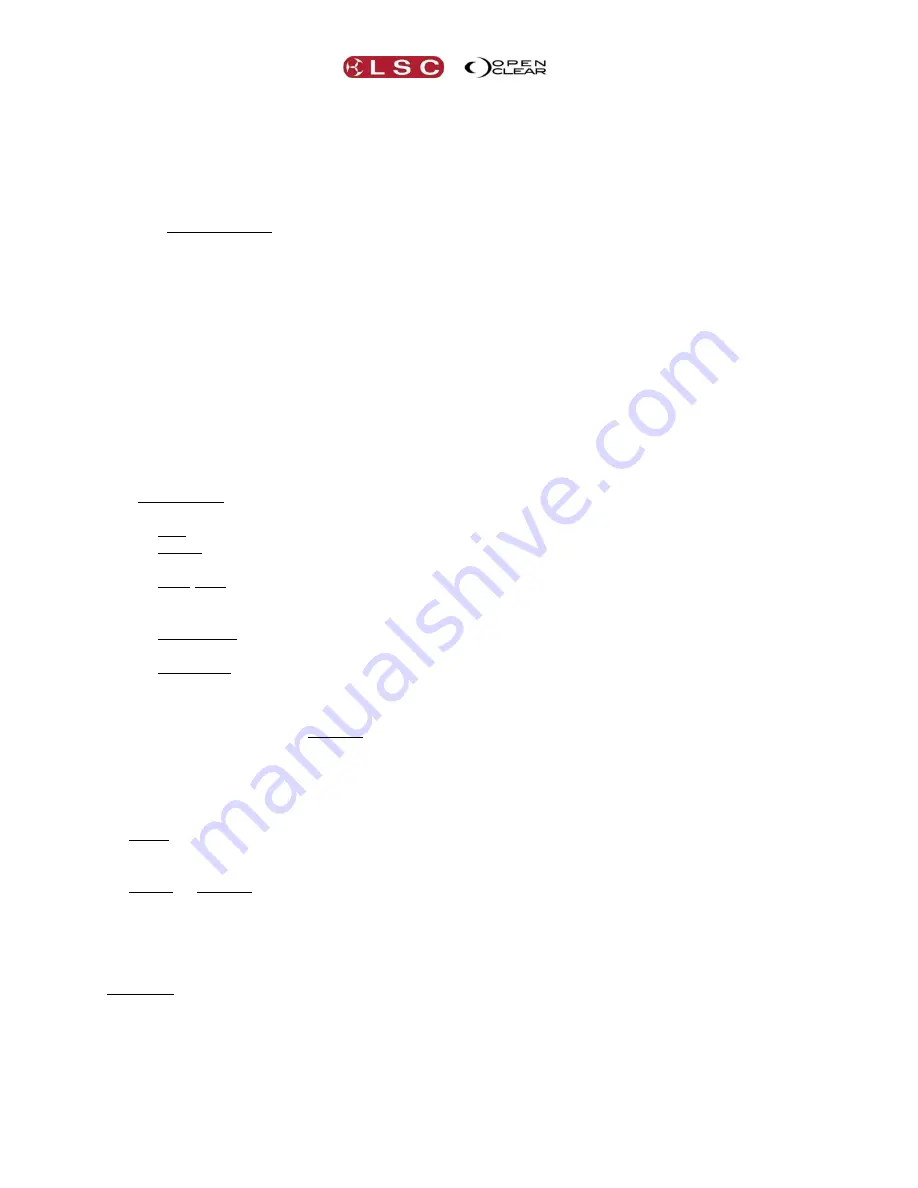
Record
Clarity
Operator Manual
Page 146
Cue name = Cue
Fade in = 0 seconds
Fade out = 2 seconds
Prior to pressing Record, you can enter your own names and settings as described below.
23.2.2
Cue-list Playback Settings and Options
When recording a
New Cue-list
, setting “Playback” to either “Tracking” (Default) or “Cue
Only” is very important as it will automatically select the appropriate options in the “Contents
Options” pane for playback in that mode. However you can change these options if you desire
or select exactly which attribute groups you want to include in the cue. See section 23.2.5
Many playback options can be selected in the Mode, Chase, lock to Tempo and Priority panes
and also by ticking your required Options. Selecting these settings and options is not essential
when recording a new cue-list because these panes and options are also available when you
configure a Playback and in the Control Booth window. You can save programming time by
ignoring all of these settings and configuring them later (if needed), prior to playback.
If you do change any of these settings they can be restored back to their default values by
pressing
Reset…
. Red boxes flash around the various sections of the screen. Touch a box to
reset the values within the box.
These Playback settings are described in section 24.2 Playback.
23.2.3
Cue Options
The Cue Options pane offers the following options……
Halt. The cue is manually played by its GO button
Follow. Click in the drop down box beside “Halt” and select “Follow”. The cue is
automatically played immediately after the previous cue finishes.
Wait time. Click and highlight the word “Halt” or “Follow” then type in a time value or
move the “Wait Time” wheel. The cue is automatically played after the wait time expires
after the previous cue finishes.
Delay Time. The time from when the cue starts until the selected attribute(s) begin to
change. The default delay time is 0 seconds.
Fade Time. The time taken for the attribute(s) to change to the value in the cue. The
default fade time is 2 seconds.
23.2.4
Existing Cue-list
When recording a cue to an existing cue-list, the new cue is usually appended to the end of the
cue-list. In the
Record Cue
dialog box, select
Existing Cue-list
allows you to select either
Recent
or
All
. Tap on a cue-list to select it. The Cues pane lists all of the existing cues in the
cue-list. The default setting is to append the new cue to the end of the existing cue-list (at the
position of the green bar as shown below).
To insert the new cue between any existing cues, touch a cue and the new cue will be inserted
before that cue. It will be automatically given an appropriate (decimal point) cue number.
To Merge or Replace and existing cue touch either
Merge
or
Replace
then touch the existing
cue to be affected.
Cue Only
(changes revert on next cue)
is an advanced function. When you are playing back
in tracking mode, there might be occasions where you want to playback a “one off” cue and you
do not want the values in that cue to track into later cues in the cue-list. This is achieved by
recording a cue as “cue only”. Ticking the
Cue only (changes revert on next cue)
will record
a cue that contains all of the touched values in the programmer and tag those channels for
playback as “q only”. When a cue-list is played back in tracking mode, any channels that are
tagged as “q only” will only affect the output state for that cue. When the next cue is played
back, the state from the most recent (non cue only) cue is restored automatically plus any new
values in the incoming cue are used.
See section 39.7.5 for more details
.
Merging a “cue only” cue into a non “cue only” cue, will only tag the merged values as “q only”.
See section 25.4 for more details
.






























